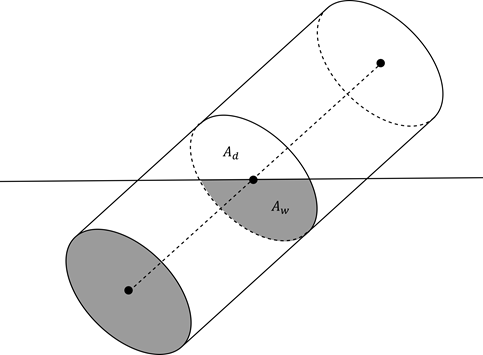When an element is fully submerged, the computation of buoyancy and hydrodynamic loading is relatively straightforward. Specifically…
•The buoyancy forces per unit length are computed based on pressure differentials, and the resultant buoyancy force effectively equates to the volume of displaced fluid. Refer to Buoyancy Forces for further details.
•The hydrodynamic forces are based on Morison’s Equation, with separate components in the normal and tangential directions for drag, added mass and added inertia. Refer to Hydrodynamic Loading for further details.
When an element is partially submerged, Flexcom adjusts the various contributions appropriately, to reflect the reduced areas and volumes involved. A number of points are noteworthy…
•Flexcom evaluates all loads on an integration point basis as it is a full finite element solver. These components loads are then transferred to element end nodes using Gaussian Quadrature.
•For surface piercing elements, the number of integration points is temporarily increased to the maximum number (which is equal to 10, assuming the user is not already using this number). This facilitate a precise distribution of the applied forces in the water line region.
•Flexcom computes the instantaneous Water Surface Elevation at each integration point based on the ambient wave loading.
•A planar cross-sectional area is computed at each integration point, normal to local element x-axis (longitudinal), as shown in the schematic below.
•If this cross-sectional area is fully submerged, buoyancy and hydrodynamic loading is applied in full.
•If this cross-sectional area is completely above the water line, buoyancy and hydrodynamic loading are set to zero.
•If this cross-sectional area is partially submerged, the ratio of submerged cross-sectional area (marked Aw in the figure) to total cross-sectional area (Aw+Ad) is used to scale the buoyancy and hydrodynamic loading to account for the effects of partial submergence.

Partially Submerged Element